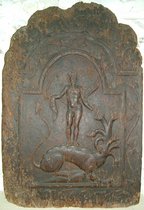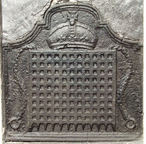-
1137
Description: Arched shape with ovolo-moulded edging; central shield with the English royal Tudor arms and an inescutcheon of a lion rampant, surrounded by a Garter with an incorrect inscription, the shield surmounted by a crown and supported on the dexter side by a dragon and on the sinister side by a greyhound; to the left of the crown, a crowned rose and the the right, a crowned portcullis; above the supporters the date 1614 is split by the shield; below, split by the Garter buckle, initials GB.
Notes: The arms are of Henry VII or Henry VIII, the inescutcheon probably representing a marriage to an heiress, but are anachronistic as the date was in the reign of James I (and VI). The initials GB are believed to relate to Gilles or Georges Boniver, who worked at the foundry at Theux, near Liège, and whose initials appear on several firebacks. The fireback is thought to be a 19th-century copy.
Copies of this fireback are known.
Inscription: 16 14 / HONI SOIT IL QVIMAL I PANSE / G B
Arms: English royal Tudor with an inescutcheon of a lion rampant
- Decoration tags:
- rounded arched (shape)
- ovolo (edging)
- whole carved pattern
- heraldic
- armorial
- royal
- text
Manufactured: in 1614 probably at Theux Furnace in the Franchimont area of Belgium.
Current location: M-Museum Leuven, 28-30 Leopold Vanderkelenstraat, Leuven, Brabant, Belgium.
(part of the Leuven Museum museum group)
-
927
Description: Carved wooden fireback pattern. Arched rectangular central panel, astragal and fillet edge, pictorial, Hercules, sword in hand, preparing to slay the Hydra; arched rectangular border, fillet edge, ivy leaves and tendrils, monogram at bottom; swirled foliage on top.
Notes: Unusually for a pattern, it was carved from a single piece of wood; formerly in the custody of William Hobday (d. 1883), last surviving ironworker at Ashburnham furnace, this pattern was given to the Sussex Archaeological Society by the Revd. J. Bickersteth.
Inscription: TAN
- Decoration tags:
- 'Dutch' (shape)
- fillet (edging)
- whole carved pattern
- pictorial
- mythological
- text
- animals
- humans
Manufactured: in the early-18th century in England.
Current location: Anne of Cleves House, Southover High Street, Lewes, East Sussex, England.
(part of the Sussex Archaeological Society museum group)
Citation: Dawson, C., 1903, 'Sussex Iron Work and Pottery', Sussex Archaeological Collections, 46, pp. 1-54.
- Attached to series:
- Patterns
- TAN series
-
592
Description: Flattened arched rectangular shape with rebated concave shoulders; double fillet edging; 11 x 9 grid portcullis with symmetrical chains in ‘S’ arrangement ending in a ring, from top corners, surmounted by an arched royal crown.
Notes: Whole pattern; the portcullis has a realistic, rather than symbolic, appearance.
Copies of this fireback are known.
- Decoration tags:
- rectangular with canted top corners and round arch (shape)
- stepped fillet (edging)
- whole carved pattern
- heraldic
- pictorial
- objects
Manufactured: in the late-16th to early-17th century in England.
Current location: Ham House, Richmond, Surrey, England.
Museum number: 1140112 (part of the National Trust museum group)
- Attached to series:
- Miscellaneous royal firebacks


